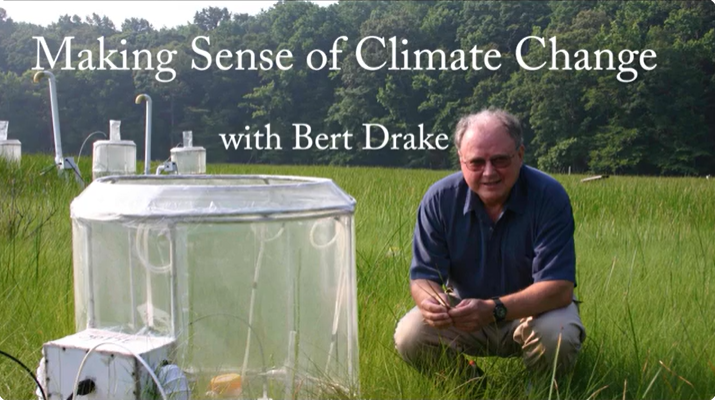



In this presentation, Scientist Bert Drake, covers a strong overview of the efforts behind the understanding and identification of climate change, and how the general consensus that it is an existing man-made problem came to be in the scientific community. Drake details the importance of the Keeling curve, made by Charles Keeling, and how his discovery in Mauna Loa, Hawaii, became a strong backbone for the present climate change research. Drake then moves us back in time, discussing Fouriers thoughts on the atmosphere (while not directly stating a climate change was occurring), he stated that the imbalance of incoming and outgoing infrared radiation is a cause for increasing temperatures. This is then detailed by Drake as one of the earliest identifications of the greenhouse effect. The next notable occurrence identified by Drake is the data recorded by Samuel Langley, who invented a machine to measure infrared radiation, but was unable to ever fully utilize his data. However Svante Arrhenius, a Swedish physicist, was able to utilize Langleys data and calculate the effects of the greenhouse effect and warned how generating more CO2 was a course for increasing the temperature. The last major historical event covered by Drake is that of Roger Revell, alongside Hans Suess (Not the Dr. Seuss youre thinking of), detailing that 80% of CO2 added to the atmosphere will stay due to the layering of existing CO2 in the oceans being unable to contain a larger volume of the gas. Drake concludes the latter half of his presentation covering the physical sciences detailing how climate change is a real, and man-made issue. Whilst utilizing the Keeling Curve, Drake showcases how there has been a 50% increase in CO2 in the northern hemisphere suggesting there are more plants, yet in almost a redundant state. One other interesting proof to showcase how humans are a leading cause of the increase in CO2, is the dilution of carbon 13 in the atmosphere, as it is being overly saturated with man-produced carbon dioxide, and as plants tend to avoid the isotope, it has virtually nowhere to remain. His last showcase before the conclusion of his presentation was showcasing a graph of observed temperatures from around 1900-2012, and then running alongside natural and human caused effects of increased climate change to see without a doubt the main driving force behind the increase in these greenhouse gases is man.
Bert Drake held a wonderfully educational and humorous presentation on climate change, allotting for both a historic and modern recap on climate change, this presentation offers a wonderful glide into the topic of climate change. His presentation can be summed into the two major categories discussed in my summary, climate change has an extensive history and is not a new phenomenon and that climate change is a direct consequence of human actions such as the industrial complex society we currently utilize globally. The historic side of his argument was wonderfully conducted in a chronological order as to showcase that bright physicists, engineers, and scientists have either been theorizing or conducting research actively on increasing temperatures for approximately the last 200 years. His utilization of this also isnt just an appeal to authority towards his predecessors, as all key points in history identified by Drake directly correlate to the birth and growth of concepts regarding climate change. This point is also extremely convincing as there are no large gaps in history where climate becomes an off-shoot issue solely focused on by one scientist, as his historic breakdown truly covers the gradual growth as opposed to simply detailing the current physical sciences of climate change on their own. His second major point he set to showcase was that climate change is not some natural phenomenon that is magically occurring alongside the progression of the world, it is detailed by him through his sources that climate change is a human propagated issue. Drake being a plant scientist I feel establishes a level of credibility that wouldnt be present had he not been in a field directly tied towards greenhouse gases and the effects of climate change. Viewing this presentation while in the Science & Global Change program was almost a review of concepts covered in class. One extreme correlation was the usage of the palm handle graph I believe in a previous SGC lecture and within Drakes presentation, where drake utilized the fluctuating nature of the graph, to showcase that before extreme human industrialization the concentration of CO2 was always under 300 ppm, and in a relatively stable fluctuation in large periods of history. One notable fact that I found unique within Drakes presentation was the concept of Carbon 13, Carbon 13 being very discriminated against by plants in the process of photosynthesis results in fuels derived or burned from will hold very low amounts of carbon 13. A graph then made from the Mauna Loa Observatory showcased that over the years, the concentration of carbon 13 is in a constant decrease, resulting from the increasing introduction of CO2 that is absent from that Isotope. In conclusion, Bert Drake conducted an extremely well made scientific and historical presentation that set out to complete two main tasks, to showcase that climate change is not a new fad and that the increasing effects of the greenhouse effect are a direct result of human activity.
The virtual field trip to the Calvert Cliffs set to showcase the what and why of the wonderful geological and historic components of the cliffs themselves. John Nance, Dr Holtz, and Dr Merck, all showcased different aspects of the area in a way to provide an understanding of the cliffs beyond simply appreciating searching for shark teeth along the coastline. The composure of the cliffs is identified as sedimentary, where clay layers and fossil layers are stacked on top of one another to form the innards of the cliff side. It is detailed that the clay layers form as a result of a lagoonal form of depositing as apposed to the cliffs spawning from some deep water basin, as the fossil layers form from being behind a barrier island that collected up and preserved the dying beings. Dr Merck details how the cliffsides come to be as a result of mass wasting, as the waves eat away undercutting land above them, large clumps of land fall off carving out the cliff sides we see today. Steven Groff within this presentation also details similarly how the cliff forms as a collection of former shallow water environments eating into offshore environments. Dr. Holtz and Dr. Merck also provided details on the lessons fossils of the area can teach whether it be fossils with damage detailing how predatory behavior existed, how as time encroaches on geologists it becomes harder to identify fossils as they begin to blend together, or how even disturbances via bioturbation can showcase biological behaviors of animals of the past. Overall, the VFE allowed for the demonstration of why we have the calvert cliffs, how we can use whats left behind by natural processes to observe different areas of history, and how fossils are layered pieces of history that go beyond dinosaur bones.
The virtual experience that was offered, is without a doubt, an extremely well made presentation that fully completes every main goal set to cover. Detailed in the beginning of every episode were three learning objectives that read, What are the processes of sedimentation and erosion, what are fossils and where do they come from, How do fossils document ancient ecosystems and environments, and all components were covered well in the series of short clips provided. Regarding the processes of sedimentation and erosion, it is explained in great detail how the silty/sandy/clay layers of past allowed for the non-fossil layers of the cliffs in that area were allowed to form from lagoonal style bodies of water complimented by the barrier islands allowing for the fossil layers to pile on top in an alternating cycle. For these cliffs specifically, rocks from the appalachian mountains region of the united states were carried down to the bay, and then coated from storms that jostled fossils into the sedimentary style that is on display today. In terms of what are fossils and where they come from, the videos showcase that fossils go far beyond being fully constructed dinosaur skeletons, and rather any preserved remains as detailed by the cherry stone clam shells detailed in movie 5. A fossil can also be classified by any form of preserved behavior from ancient ecosystems, such as the feces reinforced burroughs showcased by Dr. Merck detailing how crustaceans of old used to create habitats. The Calvert Cliffs offer some extremely world famous fossils, such as preserved megalodon teeth, also showcasing how fossils can be something as simple as a tooth with no biological matter preserved. The documentation of ancient ecosystems is showcased in how these fossils are preserved and found, or as stated, how they left behind their previous habitats. Finding trace fossils like the burroughs allows for archeologists to understand the dynamics and habits of ecosystems. There is the other instance of finding marks of attacks in fossils, showcasing the chain of dominance, or food chain, of ancient times of these older organisms, that allow for us to understand how certain hierarchies were established in these areas. In conclusion, I feel there is no need to evaluate any form of fallacies, as there are none, as well as the credibility of all the presenters within these VFE videos. Holtz, Merck, and Nance all being in the physical environment while visible detailing the evidence of the past that formed the Calvert Cliffs showcased all necessary credibility, on top of Dr Holts and Merck both being extremely intelligent in the geological field.